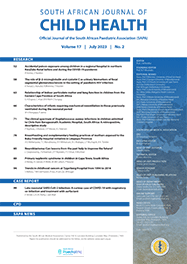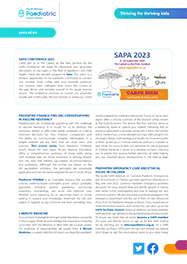Research

Family environment, socioeconomic conditions and childhood health and wellbeing in informal settlements in Mozambique
Abstract
Background. A possible relationship between slum residence and children’s health and wellbeing in sub-Saharan Africa has been relatively under-researched.
Objective. To investigate the relationship between the type of area of residence and children’s and adolescents’ health and wellbeing in urban Mozambique.
Methods. Descriptive and logistic regression techniques were employed on data from 1 913 children and 798 adolescents, to analyse several key outcomes.
Results. The descriptive findings indicate that children in slum areas are the most disadvantaged, followed by those in quasi-slum areas, in terms of school enrolment, health and the type of care received in the home. Similar descriptive results were found for the adolescents’ outcomes. Multivariate analyses showed that compared with children in slum areas, those in non-slum areas were more likely to be attending school (odds ratio (OR) 4.22; confidence interval (CI) 1.73 - 10.31), less likely to be typically sick (OR 0.26; CI 0.14 - 0.47) and less likely to be left alone in the household (OR 0.29; CI 0.18 - 0.48). Adolescents in non-slum areas tended to have completed ≥6 years of education (OR 3.01; CI 1.78 - 5.07), to be aware of HIV/AIDS programmes (OR 4.29; CI 2.43 - 7.55), to believe that HIV/AIDS may be transmitted through unprotected sex (OR 13.01; CI 3.76 - 45.02) and to have parents or caregivers who had ever talked to them about matters related to sex (OR 3.15; CI 1.76 - 5.65). Family structure and sowcioeconomic characteristics, together, account for most of the differences between slum and quasi-slum areas, particularly for children’s outcomes.
Conclusion. The health and the wellbeing of children and adolescents in slums is negatively affected, compared with other urban places in Mozambique. However, for children, family structure and other socioeconomic factors remove most slum/quasi-slum effects.
Author's affiliations
B M Cau, Department of Geography, Faculty of Arts and Social Sciences, Eduardo Mondlane University, and Centre for Research on Population and Health, Maputo, Mozambique
Full Text
Cite this article
Article History
Date published: 2018-12-14
Article Views
Full text views: 1184

.jpg)



Comments on this article
*Read our policy for posting comments here